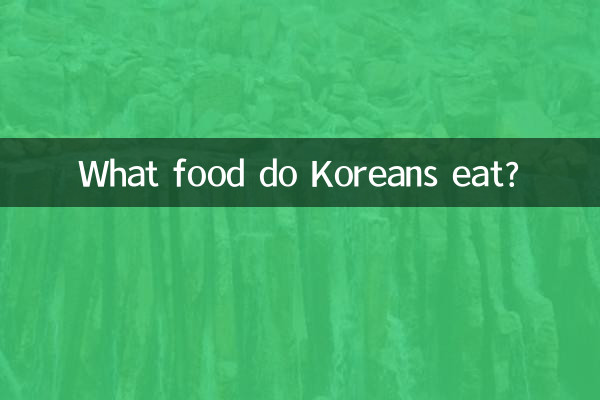What Koreans Eat: An Exploration of Food Culture from Tradition to Modernity
Korean food culture is world-famous for its diversity, healthiness and unique flavor. From traditional kimchi and barbecue to modern street snacks, Koreans’ daily diet retains their historical heritage while incorporating modern innovations. The following will combine the hot topics on the Internet in the past 10 days and use structured data to display the foods commonly eaten by Koreans and their characteristics.
1. Korean traditional staple food

| food name | main raw materials | Features |
|---|---|---|
| Kimchi | Cabbage, chili powder, garlic, ginger | Fermented foods, rich in probiotics |
| Bibimbap | Rice, vegetables, eggs, meat | Balanced nutrition, rich in color |
| Miso Soup (Doenjang-jjigae) | Doenjang, tofu, vegetables, seafood | Made from fermented soybeans and has a rich flavor |
2. Korean popular meat dishes
| food name | cooking method | Popularity |
|---|---|---|
| Korean BBQ (Samgyeopsal) | Charcoal BBQ | ★★★★★ |
| Fried Chicken (Chimaek) | Fried with beer | ★★★★☆ |
| Spicy Rice Cake (Tteokbokki) | Stir-fried with spicy sauce | ★★★★☆ |
3. Popular list of Korean street snacks
According to recent discussions on social media, the following street snacks are most popular among young people:
| Ranking | Snack name | price range | Number of internet celebrity tags |
|---|---|---|---|
| 1 | Egg Bread (Gyeran-ppang) | 2000-3000 won | # EggBread 123,000 |
| 2 | Tornado Potato | 3000-4000 won | #whirlwindpotato 98,000 |
| 3 | Korean Hotdog | 2500-3500 won | #koreanhotdog 85,000 |
4. New trends in Korean food culture
Recent data shows that Korean food is showing the following new trends:
1.The rise of healthy eating: Sales of health-improved versions of traditional foods such as low-salt kimchi and whole-grain rice increased by 35%.
2.One person food culture: The volume of takeaway orders for single-person set meals increased by 42% year-on-year, reflecting the impact of the single economy.
3.K-Food Globalization: The export volume of Korean hot sauce has maintained a growth rate of more than 20% for three consecutive years, becoming the new favorite of international kitchens.
5. Inventory of Korean specialty drinks
| Drink type | Representative products | Consumption scene |
|---|---|---|
| traditional wine | Soju, Makgeolli | Dinners, festivals |
| coffee drinks | Iced American, Caramel Macchiato | daily social interaction |
| Functional drinks | Red ginseng drink, vitamin water | health care |
Korean food culture is experiencing a perfect fusion of tradition and modernity. It can be seen from the data that it not only retains long-standing traditional foods such as kimchi and miso soup, but also develops convenient dining formats that conform to the pace of modern life. This unique food culture is the taste embodiment of Korean people’s lifestyle and values.
As K-Food’s global influence increases, Korean food is becoming an important window for the world to understand Korean culture. Whether it is improved traditional food in pursuit of health or creative street snacks, they all demonstrate Koreans’ never-ending passion for innovation in food.

check the details

check the details